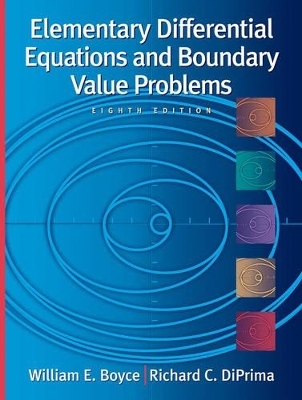
Elementary Differential Equations and Boundary Value Problems
John Wiley & Sons Inc
978-0-471-43338-5 (ISBN)
- Titel ist leider vergriffen;
keine Neuauflage - Artikel merken
This revision of the market leading book maintains its classic strengths: contemporary approach, flexible chapter construction, clear exposition, and outstanding problems. Like its predecessors, this revision is written from the viewpoint of the applied mathematician, focusing both on the theory and the practical applications of Differential Equations as they apply to engineering and the sciences. "Sound and Accurate Exposition of Theory" - special attention is made to methods of solution, analysis, and approximation. Use of technology, illustrations, and problem sets help readers develop an intuitive understanding of the material. Historical footnotes trace development of the discipline and identify outstanding individual contributions.
William E. Boyce received his B.A. degree in Mathematics from Rhodes College, and his M.S. and Ph.D. degrees in Mathematics from Carnegie-Mellon University. He is a member of the American Mathematical Society, the Mathematical Association of America, and the Society for Industrial and Applied Mathematics. He is currently the Edward P. Hamilton Distinguished Professor Emeritus of Science Education (Department of Mathematical Sciences) at Rensselaer. He is the author of numerous technical papers in boundary value problems and random differential equations and their applications. He is the author of several textbooks including two differential equations texts, and is the coauthor (with M.H. Holmes, J.G. Ecker, andW.L. Siegmann) of a text on using Maple to explore Calculus. He is also coauthor (with R.L. Borrelli and C.S. Coleman) of Differential Equations Laboratory Workbook (Wiley 1992), which received the EDUCOMBest Mathematics Curricular InnovationAward in 1993. Professor Boyce was a member of the NSF-sponsored CODEE (Consortium for Ordinary Differential Equations Experiments) that led to the widely-acclaimed ODE Architect. He has also been active in curriculum innovation and reform. Among other things, he was the initiator of the "Computers in Calculus" project at Rensselaer, partially supported by the NSF. In 1991 he received theWilliam H.Wiley Distinguished FacultyAward given by Rensselaer. Richard C. DiPrima (deceased) received his B.S., M.S., and Ph.D. degrees in Mathematics from Carnegie-Mellon University. He joined the faculty of Rensselaer Polytechnic Institute after holding research positions at MIT, Harvard, and Hughes Aircraft. He held the Eliza Ricketts Foundation Professorship of Mathematics at Rensselaer, was a fellow of the American Society of Mechanical Engineers, the American Academy of Mechanics, and the American Physical Society. He was also a member of the American Mathematical Society, the Mathematical Association of America, and the Society for Industrial and Applied Mathematics. He served as the Chairman of the Department of Mathematical Sciences at Rensselaer, as President of the Society for Industrial and Applied Mathematics, and as Chairman of the Executive Committee of the Applied Mechanics Division of ASME. In 1980, he was the recipient of theWilliam H.Wiley Distinguished Faculty Award given by Rensselaer. He received Fulbright fellowships in 1964-65 and 1983 and a Guggenheim fellowship in 1982-83. He was the author of numerous technical papers in hydrodynamic stability and lubrication theory and two texts on differential equations and boundary value problems. Professor DiPrima died on September 10, 1984.
Preface.Chapter 1. Introduction.1.1 Some Basic Mathematical Models; Direction Fields.1.2 Solutions of Some Differential Equations.1.3 Classi.cation of Differential Equations.1.4 Historical Remarks.Chapter 2. First Order Differential Equations.2.1 Linear Equations; Method of Integrating Factors.2.2 Separable Equations.2.3 Modeling with First Order Equations.2.4 Differences Between Linear and Nonlinear Equations.2.5 Autonomous Equations and Population Dynamics.2.6 Exact Equations and Integrating Factors.2.7 Numerical Approximations: Euler's Method.2.8 The Existence and Uniqueness Theorem.2.9 First Order Difference Equations.Chapter 3. SecondOrd er Linear Equations.3.1 Homogeneous Equations with Constant Coeficients.3.2 Fundamental Solutions of Linear Homogeneous Equations.3.3 Linear Independence and the Wronskian.3.4 Complex Roots of the Characteristic Equation.3.5 Repeated Roots; Reduction of Order.3.6 Nonhomogeneous Equations; Method of Undetermined Coeficients.3.7 Variation of Parameters.3.8 Mechanical and Electrical Vibrations.3.9 Forced Vibrations.Chapter 4. Higher Order Linear Equations.4.1 General Theory of nth Order Linear Equations.4.2 Homogeneous Equations with Constant Coeficients.4.3 The Method of Undetermined Coeficients.4.4 The Method of Variation of Parameters.Chapter 5. Series Solutions of Second Order Linear Equations.5.1 Review of Power Series.5.2 Series Solutions Near an Ordinary Point, Part I.5.3 Series Solutions Near an Ordinary Point, Part II.5.4 Regular Singular Points.5.5 Euler Equations.5.6 Series Solutions Near a Regular Singular Point, Part I.5.7 Series Solutions Near a Regular Singular Point, Part II.5.8 Bessel's Equation.Chapter 6. The Laplace Transform.6.1 De.nition of the Laplace Transform.6.2 Solution of Initial Value Problems.6.3 Step Functions.6.4 Differential Equations with Discontinuous Forcing Functions.6.5 Impulse Functions.6.6 The Convolution Integral.Chapter 7. Systems of First Order Linear Equations.7.1 Introduction.7.2 Review of Matrices.7.3 Linear Algebraic Equations; Linear Independence, Eigenvalues, Eigenvectors.7.4 Basic Theory of Systems of First Order Linear Equations.7.5 Homogeneous Linear Systems with Constant Coeficients.7.6 Complex Eigenvalues.7.7 Fundamental Matrices.7.8 Repeated Eigenvalues.7.9 Nonhomogeneous Linear Systems.Chapter 8. Numerical Methods.8.1 The Euler or Tangent Line Method.8.2 Improvements on the Euler Method.8.3 The Runge-Kutta Method.8.4 Multistep Methods.8.5 More on Errors; Stability.8.6 Systems of First Order Equations.Chapter 9. Nonlinear Differential Equations andStability.9.1 The Phase Plane: Linear Systems.9.2 Autonomous Systems and Stability.9.3 Almost Linear Systems.9.4 Competing Species.9.5 Predator-Prey Equations.9.6 Liapunov's Second Method.9.7 Periodic Solutions and Limit Cycles.9.8 Chaos and Strange Attractors: The Lorenz Equations.Chapter 10. Partial Differential Equations andF ourier Series.10.1 Two-Point Boundary Value Problems.10.2 Fourier Series.10.3 The Fourier Convergence Theorem.10.4 Even and Odd Functions.10.5 Separation of Variables; Heat Conduction in a Rod.10.6 Other Heat Conduction Problems.10.7 TheWave Equation: Vibrations of an Elastic String.10.8 Laplace's Equation.AppendixA Derivation of the Heat Conduction Equation.Appendix B Derivation of theWave Equation.Chapter 11. Boundary Value Problems.11.1 The Occurrence of Two-Point Boundary Value Problems.11.2 Sturm-Liouville Boundary Value Problems.11.3 Nonhomogeneous Boundary Value Problems.11.4 Singular Sturm-Liouville Problems.11.5 Further Remarks on the Method of Separation of Variables: A Bessel Series Expansion.11.6 Series of Orthogonal Functions: Mean Convergence.Answers to Problems.Index.
| Erscheint lt. Verlag | 25.7.2005 |
|---|---|
| Verlagsort | New York |
| Sprache | englisch |
| Maße | 209 x 261 mm |
| Gewicht | 1660 g |
| Themenwelt | Mathematik / Informatik ► Mathematik |
| ISBN-10 | 0-471-43338-1 / 0471433381 |
| ISBN-13 | 978-0-471-43338-5 / 9780471433385 |
| Zustand | Neuware |
| Haben Sie eine Frage zum Produkt? |
aus dem Bereich

